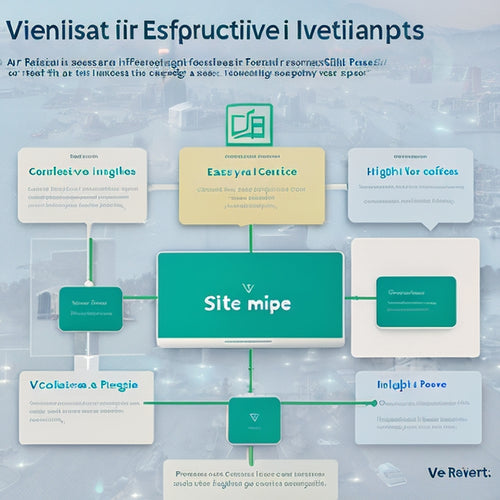
Unlock Ecommerce Success With Online Courses
Share
By enrolling in online courses, you're taking the first important step towards opening ecommerce success, as you'll gain the expertise and strategies needed to identify and fix pain points, optimize your sales funnel, and boost customer satisfaction, ultimately driving your online store towards exponential growth and profitability. You'll learn how to analyze customer behavior, track key metrics, and leverage customer feedback to inform your business decisions. With the right skills and knowledge, you'll be able to refine your ecommerce strategy, streamline operations, and focus on driving repeat business and loyalty - all of which are essential for achieving sustainable success. Now, you're ready to discover the secrets to thriving in the competitive ecommerce landscape.
Key Takeaways
• Identify ecommerce pain points through customer feedback and analytics to optimize online store performance and improve customer satisfaction.
• Leverage digital product analytics tools to gather insights on customer behavior, preferences, and needs to refine ecommerce strategy.
• Set up data tracking tools to collect accurate insights, identify bottlenecks, and optimize customer journey for maximum satisfaction.
• Analyze customer journey metrics, sales funnel performance, and customer feedback to inform data-driven decisions and drive ecommerce success.
• Scale ecommerce business growth by prioritizing customer retention, streamlining operations, and making data-driven decisions to foster loyalty and advocacy.
Identifying Ecommerce Pain Points
As you navigate the ecommerce landscape, pinpointing areas that hinder your online store's performance is essential, and it starts with identifying the pain points that are silently eating into your profits. You can't fix what you don't know, so it's vital to get to the root of the issues holding you back.
One way to do this is by focusing on customer satisfaction. Are your customers happy with their shopping experience? Are they getting what they want quickly and easily? If not, you need to dig deeper to understand their pain points and address them.
Conducting thorough market research is also key. This involves gathering data on your target audience, their preferences, and their behaviors. By analyzing this data, you'll be able to identify areas where you can improve, optimize, and refine your ecommerce strategy.
Choosing Digital Product Analytics
You've pinpointed your ecommerce pain points and gathered valuable market research, now it's time to select digital product analytics tools that will help you turn that data into actionable insights. With so many options available, it's crucial to choose tools that align with your business goals and objectives.
Here are four key considerations to keep in mind when selecting digital product analytics tools:
-
Data visualization techniques: Look for tools that provide intuitive and interactive dashboards to help you visualize your data, making it easier to identify trends and patterns.
-
Customer behavior analysis: Choose tools that offer advanced customer behavior analysis, enabling you to gain a deeper understanding of your customers' needs and preferences.
-
A/B testing methods: Select tools that provide robust A/B testing capabilities, allowing you to experiment with different product variations and measure their impact on customer behavior.
- Competitor benchmarking: Opt for tools that offer competitor benchmarking features, enabling you to compare your performance with that of your competitors and identify areas for improvement.
Setting Up Data Tracking Tools
Now that you've chosen the right digital product analytics tools, it's essential to set them up correctly, ensuring seamless data tracking and accurate insights.
You need to configure the tools to collect data that aligns with your business goals, such as conversion rate optimization and customer behavior analysis. This will enable you to identify areas for improvement and make data-driven decisions.
When setting up your data tracking tools, consider implementing data visualization techniques to make complex data more manageable and actionable. This will help you spot trends and patterns in your data, allowing you to stay on top of data analysis trends.
By doing so, you'll be able to pinpoint bottlenecks in your customer journey and optimize your strategy accordingly. Remember, the key to accessing ecommerce success lies in leveraging data to inform your decisions.
Measuring Customer Journey Metrics
With your data tracking tools set up, you can start measuring customer journey metrics to gain a deeper understanding of how customers interact with your online store. This is where the real insights begin, as you'll be able to identify areas of improvement and optimize your store for maximum customer satisfaction.
Here are some key metrics to focus on:
-
Customer Retention Rate: How many customers come back to your store, and how often?
-
Bounce Rate: Are visitors leaving your site immediately, or are they engaging with your content?
-
Average Order Value: How much are customers spending on average, and how can you increase this number?
- User Experience Metrics: How easy is it for customers to navigate your site, find what they're looking for, and complete a purchase?
Analyzing Sales Funnel Performance
As you analyze your sales funnel's performance, you'll want to scrutinize its conversion rates - the percentage of visitors who complete each step - to identify areas for improvement.
You'll also need to track key metrics, such as cart abandonment rates and average order values, to get a clear picture of your funnel's strengths and weaknesses.
Funnel Conversion Rates
You need to track your funnel conversion rates to identify bottlenecks in your sales process and optimize it for maximum ROI. This essential metric reveals how well each stage of your funnel is performing, helping you pinpoint areas that need improvement.
By analyzing your funnel conversion rates, you can refine your strategy to increase sales and revenue.
Here are 4 key strategies to boost your funnel conversion rates:
-
A/B testing: Experiment with different landing page variations, email subject lines, and Calls-to-Action (CTAs) to find what resonates best with your audience.
-
Customer segmentation: Divide your customers into distinct groups based on demographics, behavior, or preferences to tailor your messaging and offers.
-
Streamline your checkout process: Simplify and speed up the payment process to reduce cart abandonment rates.
- Personalize your communication: Tailor your emails and messages to individual customers' needs and interests to build trust and loyalty.
Tracking Key Metrics
Optimizing your sales funnel requires a deep understanding of its performance, which is where tracking key metrics comes in – an crucial step in analyzing your sales funnel's strengths, weaknesses, and areas for improvement. You need to know which metrics to track and how to use the data to make informed decisions.
One critical metric is your conversion rate, which tells you what percentage of visitors complete a desired action. By tracking your conversion rate, you can identify bottlenecks in your funnel and make adjustments to improve it.
Another essential metric is customer retention, which measures how well you're able to keep customers coming back. By analyzing customer retention, you can identify opportunities to improve customer satisfaction and loyalty.
Uncovering Hidden Revenue Leaks
Dig into your ecommerce data and you'll likely unearth a staggering amount of money slipping through the cracks, hidden from view in the form of abandoned carts, failed payments, and overlooked upsell opportunities.
These revenue leaks can be devastating to your bottom line, but the good news is that they can be identified and plugged with the right strategies.
Here are 4 key areas to focus on to uncover hidden revenue leaks:
-
Abandoned carts: Identify why customers are leaving their carts behind and implement strategies to win them back, such as email reminders or special offers.
-
Failed payments: Analyze why payments are failing and optimize your payment process to reduce friction and improve success rates.
-
Overlooked upsell opportunities: Look for opportunities to offer complementary products or services to increase average order value and boost revenue.
- Inefficient shipping: Optimize your shipping process to reduce costs and improve delivery times, leading to increased customer satisfaction and loyalty.
Optimizing Conversion Rate Strategies
Enhancing Conversion Rate Strategies
By streamlining your checkout process, simplifying product information, and leveraging social proof, you can greatly boost conversion rates and transform browsers into buyers.
To take it to the next level, you need to dive deeper into A/B testing techniques. This will help you identify which elements on your website are hindering conversions and make data-driven decisions to optimize them.
Additionally, incorporating customer retention strategies will guarantee that once you've converted a customer, you can keep them coming back for more.
Your website optimization strategy should also involve social media marketing to drive targeted traffic to your site. By using social media platforms to promote your products and engage with your audience, you can increase brand awareness and drive sales.
Also, make sure your website is optimized for mobile devices, as more and more customers are shopping on-the-go. By implementing these strategies, you'll be well on your way to maximizing your conversion rates and accessing ecommerce success.
Leveraging Customer Feedback Insights
When you're building a successful ecommerce business, you can't afford to ignore what your customers are telling you. By analyzing their feedback, you'll uncover the product pain points that are driving them crazy, and identify opportunities to improve.
This is where the voice of your users becomes your most valuable asset, guiding you to make data-driven decisions that boost customer satisfaction and loyalty.
Product Pain Points
Leveraging customer feedback insights helps you identify and address product pain points that are frustrating your customers and hindering your ecommerce success. By listening to your customers, you can pinpoint areas where your product is falling short, and make targeted improvements to enhance user experience and boost customer retention.
Here are 4 key benefits of addressing product pain points:
-
Improved customer satisfaction: By resolving pain points, you can notably increase customer satisfaction, leading to positive reviews, repeat business, and word-of-mouth referrals.
-
Increased conversion rates: When you address pain points, you can simplify the buying process, reduce friction, and enhance the likelihood of customers completing their purchases.
-
Reduced support queries: By fixing common issues, you can decrease the volume of support requests, freeing up resources to focus on growth and development.
- Competitive advantage: By prioritizing customer feedback and addressing pain points, you can differentiate your brand and establish a reputation for exceptional customer experience.
Voice of Users
By tapping directly into customer feedback, you gain a profound understanding of their needs, preferences, and pain points, allowing you to craft a tailored ecommerce experience that resonates deeply with your target audience. This valuable insight enables you to create an online store that truly meets their expectations, resulting in increased customer satisfaction and loyalty.
By listening to the voice of users, you can identify areas of improvement and optimize your website's user experience. This might involve streamlining navigation, simplifying checkout processes, or enhancing product information.
Scaling Ecommerce Business Growth
As you work to take your ecommerce business to the next level, scaling growth becomes a critical component of your strategy, requiring careful planning and execution to avoid common pitfalls and secure sustainable success. You've worked hard to get to this point, and now it's time to think strategically about how to maintain momentum.
To scale your ecommerce business effectively, focus on the following key areas:
-
Customer retention: Develop strategies to keep your customers coming back, such as loyalty programs, personalized marketing, and exceptional customer service.
-
Streamlined operations: Identify areas where you can automate processes, outsource tasks, or optimize workflows to increase efficiency and reduce costs.
-
Data-driven decision making: Leverage analytics and performance metrics to inform your business decisions, ensuring you're making data-backed choices that drive growth.
- Brand loyalty: Foster a strong brand identity that resonates with your target audience, encouraging loyalty and advocacy that drives long-term success.
Frequently Asked Questions
Can I Create Online Courses With Limited Technical Expertise?
"You can craft compelling online courses despite limited technical expertise, leveraging user-friendly course creation platforms and savvy marketing strategies to showcase your content creation and engagement techniques, ultimately driving learner success."
How Long Does It Take to Develop a Profitable Online Course?
You'll likely spend 2-6 months developing a profitable online course, depending on complexity and your workload. Set realistic profitability expectations, aiming for a minimum of $1,000 per month within the first year, and scale from there.
What Types of Ecommerce Businesses Benefit From Online Courses?
You'll thrive in B2B ecommerce and niche markets with online courses, as they establish authority and trust. Meanwhile, dropshipping and digital products businesses can also benefit, allowing you to diversify revenue streams and build loyal customer bases.
Can Online Courses Be Used for Customer Retention and Loyalty?
'You're the master key that opens customer loyalty, and online courses are the golden threads that weave a tapestry of brand devotion, fostering customer engagement and loyalty that lasts a lifetime, not just a sale.'
Are Online Courses Only Suitable for B2C Ecommerce Businesses?
You might think online courses are only for B2C ecommerce, but you're wrong; they're equally effective for B2B ecommerce, where creating valuable content can establish your brand as a thought leader and drive sales.
Related Posts
-

Why and How to Create a Sitemap for Improved SEO
This article explores the significance of creating a sitemap for enhanced search engine optimization (SEO) and provi...
-

Does Having a Sitemap Help SEO
This article examines the potential impact of sitemaps on search engine optimization (SEO) practices. It explores th...
-

What Does It Take to Succeed in Shopify
Shopify, a popular e-commerce platform, offers numerous benefits and opportunities for success. This article aims to...


